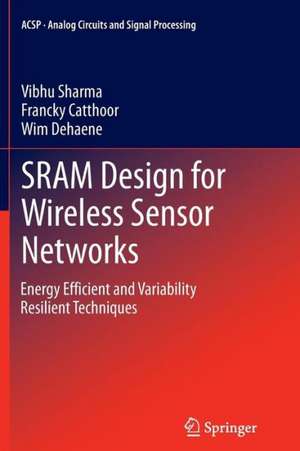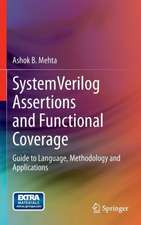SRAM Design for Wireless Sensor Networks: Energy Efficient and Variability Resilient Techniques: Analog Circuits and Signal Processing
Autor Vibhu Sharma, Francky Catthoor, Wim Dehaeneen Limba Engleză Paperback – 8 aug 2014
| Toate formatele și edițiile | Preț | Express |
|---|---|---|
| Paperback (1) | 635.01 lei 6-8 săpt. | |
| Springer – 8 aug 2014 | 635.01 lei 6-8 săpt. | |
| Hardback (1) | 641.03 lei 6-8 săpt. | |
| Springer – 27 iul 2012 | 641.03 lei 6-8 săpt. |
Din seria Analog Circuits and Signal Processing
- 5%
 Preț: 902.97 lei
Preț: 902.97 lei - 9%
 Preț: 629.00 lei
Preț: 629.00 lei -
 Preț: 388.34 lei
Preț: 388.34 lei - 15%
 Preț: 636.30 lei
Preț: 636.30 lei - 15%
 Preț: 636.80 lei
Preț: 636.80 lei - 18%
 Preț: 941.82 lei
Preț: 941.82 lei - 15%
 Preț: 639.08 lei
Preț: 639.08 lei - 18%
 Preț: 918.48 lei
Preț: 918.48 lei - 15%
 Preț: 631.21 lei
Preț: 631.21 lei - 15%
 Preț: 642.03 lei
Preț: 642.03 lei - 15%
 Preț: 641.85 lei
Preț: 641.85 lei - 18%
 Preț: 887.05 lei
Preț: 887.05 lei - 18%
 Preț: 944.51 lei
Preț: 944.51 lei - 15%
 Preț: 632.55 lei
Preț: 632.55 lei - 15%
 Preț: 641.03 lei
Preț: 641.03 lei - 18%
 Preț: 836.39 lei
Preț: 836.39 lei - 15%
 Preț: 642.18 lei
Preț: 642.18 lei - 15%
 Preț: 639.90 lei
Preț: 639.90 lei - 18%
 Preț: 947.85 lei
Preț: 947.85 lei - 15%
 Preț: 642.51 lei
Preț: 642.51 lei - 15%
 Preț: 631.86 lei
Preț: 631.86 lei - 15%
 Preț: 634.49 lei
Preț: 634.49 lei - 15%
 Preț: 635.47 lei
Preț: 635.47 lei - 15%
 Preț: 640.06 lei
Preț: 640.06 lei - 15%
 Preț: 631.53 lei
Preț: 631.53 lei - 15%
 Preț: 635.65 lei
Preț: 635.65 lei - 18%
 Preț: 941.50 lei
Preț: 941.50 lei - 18%
 Preț: 1112.92 lei
Preț: 1112.92 lei - 15%
 Preț: 636.30 lei
Preț: 636.30 lei - 15%
 Preț: 633.19 lei
Preț: 633.19 lei - 15%
 Preț: 635.80 lei
Preț: 635.80 lei - 18%
 Preț: 888.01 lei
Preț: 888.01 lei - 18%
 Preț: 942.76 lei
Preț: 942.76 lei - 18%
 Preț: 1387.10 lei
Preț: 1387.10 lei - 18%
 Preț: 1115.28 lei
Preț: 1115.28 lei - 15%
 Preț: 633.68 lei
Preț: 633.68 lei - 15%
 Preț: 641.03 lei
Preț: 641.03 lei - 15%
 Preț: 638.57 lei
Preț: 638.57 lei - 15%
 Preț: 642.51 lei
Preț: 642.51 lei - 18%
 Preț: 947.85 lei
Preț: 947.85 lei - 15%
 Preț: 640.71 lei
Preț: 640.71 lei - 15%
 Preț: 640.88 lei
Preț: 640.88 lei - 15%
 Preț: 631.40 lei
Preț: 631.40 lei - 18%
 Preț: 944.19 lei
Preț: 944.19 lei - 18%
 Preț: 944.67 lei
Preț: 944.67 lei - 18%
 Preț: 942.94 lei
Preț: 942.94 lei - 15%
 Preț: 641.20 lei
Preț: 641.20 lei - 20%
 Preț: 555.53 lei
Preț: 555.53 lei - 18%
 Preț: 1003.38 lei
Preț: 1003.38 lei
Preț: 635.01 lei
Preț vechi: 747.06 lei
-15% Nou
Puncte Express: 953
Preț estimativ în valută:
121.51€ • 129.94$ • 101.31£
121.51€ • 129.94$ • 101.31£
Carte tipărită la comandă
Livrare economică 18 aprilie-02 mai
Preluare comenzi: 021 569.72.76
Specificații
ISBN-13: 9781489992154
ISBN-10: 1489992154
Pagini: 184
Ilustrații: XII, 172 p.
Dimensiuni: 155 x 235 x 10 mm
Greutate: 0.27 kg
Ediția:2013
Editura: Springer
Colecția Springer
Seria Analog Circuits and Signal Processing
Locul publicării:New York, NY, United States
ISBN-10: 1489992154
Pagini: 184
Ilustrații: XII, 172 p.
Dimensiuni: 155 x 235 x 10 mm
Greutate: 0.27 kg
Ediția:2013
Editura: Springer
Colecția Springer
Seria Analog Circuits and Signal Processing
Locul publicării:New York, NY, United States
Public țintă
ResearchCuprins
Introduction.- SRAM Bit Cell Optimization.- Adaptive Voltage Optimization Techniques: Low Voltage SRAM Operation.- Circuit Techniques to Assist SRAM Cell: Local Assist Circuitry.- SRAM Energy Reduction Techniques.- Variation Tolerant Low Power Sense Amplifiers.- Prototypes.- Conclusions.
Textul de pe ultima copertă
This book features various, ultra low energy, variability resilient SRAM circuit design techniques for wireless sensor network applications. Conventional SRAM design targets area efficiency and high performance at the increased cost of energy consumption, making it unsuitable for computation-intensive sensor node applications. This book, therefore, guides the reader through different techniques at the circuit level for reducing energy consumption and increasing the variability resilience. It includes a detailed review of the most efficient circuit design techniques and trade-offs, introduces new memory architecture techniques, sense amplifier circuits and voltage optimization methods for reducing the impact of variability for the advanced technology nodes.
- Discusses fundamentals of energy reduction for SRAM circuits and applies them to energy limitation challenges associated with wireless sensor nodes;
- Explains impact of variability resilience in reducing the energy consumption;
- Describes various memory architectures and provides detailed overview of different types of SRAM cells;
- Includes sense amplifier design techniques for solving energy-offset tradeoff.
Caracteristici
Discusses fundamentals of energy reduction for SRAM circuits and applies them to energy limitation challenges associated with wireless sensor nodes Explains impact of variability resilience in reducing the energy consumption Describes various memory architectures and provides detailed overview of different types of SRAM cells Includes sense amplifier design techniques for solving energy-offset tradeoff Includes supplementary material: sn.pub/extras












